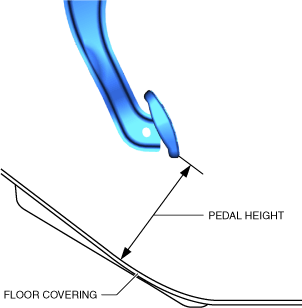BRAKE PEDAL INSPECTION
id041100700400
Pedal Height Inspection
1. Measure the distance from the floor covering to the position (pedal pad lower end and center) shown in the figure of the upper surface of the pedal pad and verify that it is as specified.
-
• If not within the specification, inspect the following items and repair or replace the applicable part if there is any malfunction.
-
― Electronically controlled brake unit installation condition
― Deformation of or damage to the electronically controlled brake unit fork
― Brake pedal installation condition
― Clevis pin wear
-
Brake pedal height (reference value)
-
108.6 mm {4.276 in}
-
Pedal Play Inspection
1. Pump the pedal several times.
2. Gently depress the pedal by hand and measure the pedal play.
-
Brake pedal play
-
3 mm {0.1 in} or less
-
-
Pedal-to-floor Clearance Inspection
1. Start the engine and depress the brake pedal with a force of 147 N {15.0 kgf, 33.0 lbf}.
2. Measure the distance from the center of the upper surface of the pedal pad to the floor covering and verify that it is as specified.
-
Brake pedal-to-floor clearance (Brake pedal when depressed at 147 N {15.0 kgf, 33.0 lbf})
-
65.6 mm {2.58 in}
-
• If it is less than the standard, perform the Self-Diagnosing Brake Line using the M-MDS.
- (1) Connect the M-MDS.
-
- (2) Switch the ignition ON (engine off or on).
-
- (3) Select the following item from the screen of the M-MDS.
-
- 1) Press [Start] for the vehicle identification.
-
- 2) Press the [Toolbox] tab.
-
- 3) Press the [Work Support] icon.
-
- 4) Press the [BRAKES] icon.
-
- 5) Press [Run] for Self-Diagnosing Brake Line.
-
-
• If there is any malfunction, inspect for brake fluid leakage and then bleed the air using the M-MDS. (See
BRAKE FLUID AIR BLEEDING.)
